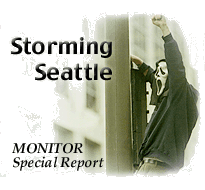
Aftermath
by Paul de Armond
 |
by Paul de Armond |
|
The
WTO protests in Seattle were the largest scale left-wing demonstrations in America since the Gulf War. They were also the most successful American political demonstrations of the decade. Success for a demonstration is measured by the degree of congruence between the protesters goals and the effect on public policy issues.
Victory in protest is obtained when the establishment concedes the protesters right to exist. In Seattle, that occured on Thursday when the protests were escorted by police and not attacked by them. On Friday, the protests began to evolve into negotiation over the terms of release for jailed protesters. The abrogation of those agreements by City Attorney Mark Sidran only delayed the negotiations, which concluded with the dismissal of criminal charges against almost all of those arrested. The WTO protests succeeded in the streets by a combination of strategic surprise and tactical openness. The three key phases of the street actions were: the Tuesday morning "swarm" which blockaded strategic intersections; the collapse of the police strategy to suppress the Direct Action Network protests while allowing the AFL-CIO parade; and the failure of the AFL-CIO parade to engulf the Direct Action Network protests into a form acceptable to the Clinton administration.
|
|
Throughout
the week, the only thing that the Direct Action Network had to accomplish to achieve victory was to continue protesting. Their opponents, the police and the AFL-CIO, were faced with the much more difficult task of making the Direct Action Network disappear, either into jail or by being brought under the control of the labor unions. Neither of these goals was realistic or feasible, due to the numbers which the Direct Action Network was able to mobilize.
The failure of the police strategy was almost instantaneous with the success of the blockade. Non-violent civil disobedience usually succeeds when the numbers of protesters is sufficiently large. The use of force to disperse such demonstrations is a moral victory for the protesters if it succeeds and a double victory if it fails. In Seattle, the attempts to forcibly disperse the demonstrations not only failed, but also set into motion a chain of events which undermined the legitimacy of the police actions. Police lost control of their own strategy began with the initial use of tear gas. The circumstances surrounding the decision to use gas are still unknown, as is where the decision orginated. The pursuit of demonstrators up Capitol Hill on Tuesday and Wednesday nights accelerated the collapsing strategy of forcible dispersion. On Wednesday night, the failure of civilian officials to control the police dramatically underscored the breakdown of political control. On Thursday, the refusal of the City Council to ratify the mayor's emergency declarations began the process of regaining political control of the police. And the January dismissal of charges against demonstrators underscored the tenuous legality of the city's actions against the protesters. The situtation for the labor unions was equally unsuccessful. The voices among the labor alliance were divided as to whether Seattle was a victory or a defeat. The most immediate effect of the protests was the virtual disappearance of the Teamsters and right-wingers like Pat Buchanan from the alliance. In the sense that nationalist and protectionist forces seemed to prevail in the trade debate, the WTO protests represented a policy move to the right: a paradoxical success for right-wing policy.
At least one "mainstream" environmental organization, the National Wildlife Federation, issued a statement calling the WTO protests a defeat for the labor alliance. Federation president Mark van Putten said violence by some demonstrators overshadowed the message of the mainstream environmental groups and labor unions that led the protests. This interpretation is the same as President Clinton's remarks about the protests -- framing the dissenting position as criminal and illegitimate. "When I turned on the TV at night, I didn't see tens of thousands of peaceful demonstrators calling for better environmental protections," van Putten said. "I saw people in masks breaking windows." At the same time, van Putten warned that more protests can be expected.
Albion Monitor
February 29, 2000 (http://www.monitor.net/monitor) All Rights Reserved. Contact rights@monitor.net for permission to use in any format. | ||||||||